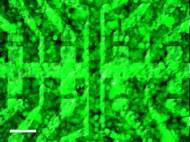Biocompatible graphene transistor array reads cellular signals
 Research that could lead to compensation for some sort of neural damage, or monitor how our bodies function, may seem like something you see in science fiction. However, bioelectronic applications could get a step closer because a team of researchers from the Technical University of Munich and the Juelich Research Center developed a graphene-based transistor array that is compatible with living biological cells.
Research that could lead to compensation for some sort of neural damage, or monitor how our bodies function, may seem like something you see in science fiction. However, bioelectronic applications could get a step closer because a team of researchers from the Technical University of Munich and the Juelich Research Center developed a graphene-based transistor array that is compatible with living biological cells.
Bioelectronic applications today utilize silicone, but researchers emphasized that both flexible substrates and watery biological environments present a serious problem for silicon devices, and they may be unreliable for communication with individual nerve cells. On the other hand, graphene is chemically stable, it has great electronic performance, and it is easily manufactured at large-scale and low-cost.
In order to confirm these properties, the TUM-Juelich team performed research on an array of 16 graphene solution-gated field-effect transistors (G-SGFETs) fabricated on copper foil by chemical vapor deposition and standard photolithographic and etching processes.
“The sensing mechanism of these devices is rather simple”, said Dr. Jose Antonio Garrido, a member of the Walter Schottky Institute at TUM. “Variations of the electrical and chemical environment in the vicinity of the FET gate region will be converted into a variation of the transistor current.”
The researchers grew a layer of biological cells similar to heart muscle directly on top of this array, and managed to detect action potentials of individual cells with high spatial and temporal resolution. Action potential is a short-lasting event in which the electrical membrane potential of a cell rapidly rises and falls and it is a triggering signal that varies with cell type. For example, in muscle cells it triggers a series of events that lead to muscle contraction, while in neurons it plays the role in cell-to-cell communication.
The array managed to detect a series of spikes separated by tens of milliseconds, and once the cell layer was exposed to a higher concentration of norepinephrine (a stress hormone which acts as neurotransmitter) a corresponding increase in the frequency of spikes was recorded. In other experiments related to inherent noise level of the G-SFETs, the results showed that its performance matches currently available ultralow-noise silicon devices.
“Much of our ongoing research is focused on further improving the noise performance of graphene devices, and on optimizing the transfer of this technology to flexible substrates such as parylene and kapton, both of which are currently used for in vivo implants”, said Garrido. “We are also working to improve the spatial resolution of our recording devices.”
Graphene’s properties could enable its wide use in future biomedical applications, and researchers are already collaborating with scientists at the Paris-based Vision Institute to investigate the biocompatibility of graphene layers in cultures of retinal neuron cells, as well as within a broader European project called NEUROCARE, which aims at developing brain implants based on flexible nanocarbon devices.
For more information, read the article published in the journal Advanced Materials named: “Graphene Transistor Arrays for Recording Action Potentials from Electrogenic Cells“.









The beginning of Borg-like technology?